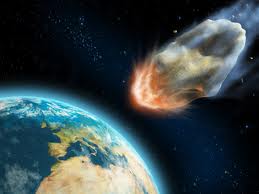|
Earn up to ₹40 per post as scholarship. Unlimited earning potential per month. |
 Asteroid have always been a subject of curiosity and dread to common man and scientists alike. Since its formation about 4.5 billion years ago, Earth has been hit many times with asteroids and comets. A few of them are understood to have their orbits into the inner solar system and close to the Earth. These objects are collectively known as Near Earth Objects (NEOs) which still pose danger to Earth today. Massive damage can occur by their collisions. We know that such collisions in past had wiped out Dinosaurs. A comet identified as Shoemaker-Levy broke into fragments and crashed into the atmosphere of Jupiter in 1994. If it were the Earth instead, we would have suffered global catastrophe. Though most of those objects are harmless, one in thousand has its orbit which crosses that of Earth raising possibility of future collision.
Asteroid have always been a subject of curiosity and dread to common man and scientists alike. Since its formation about 4.5 billion years ago, Earth has been hit many times with asteroids and comets. A few of them are understood to have their orbits into the inner solar system and close to the Earth. These objects are collectively known as Near Earth Objects (NEOs) which still pose danger to Earth today. Massive damage can occur by their collisions. We know that such collisions in past had wiped out Dinosaurs. A comet identified as Shoemaker-Levy broke into fragments and crashed into the atmosphere of Jupiter in 1994. If it were the Earth instead, we would have suffered global catastrophe. Though most of those objects are harmless, one in thousand has its orbit which crosses that of Earth raising possibility of future collision.
NASA has announced recently their plans about landing its astronauts on asteroid VESTA before 2030. One of the astronauts is Maj. Tim Peake, a former British Army Helicopter Test Pilot – an astronaut with European Space Agency, Peake and other five astronauts will be sent to an underwater base off the cost of Florida next month where they will spend 12 days 20 meters beneath the surface of the Atlantic to simulate working in the low gravity environment of an Asteroid.
During the training the astronauts will stay in a capsule (12 meters by 6 meters) where they will live, eat, sleep as part of training. Spacecraft Dawn was sent in space in the year 2007, which is circling VESTA since 2011. It has sent 20,000 images and spectra data is collected from different wavelengths of radiations.
Asteroid VESTA was discovered by Heinrich Wilhelm Olbers on March 29, 1807. It is named after the goddess of home and hearth from Roman mythology. It is the second largest in the asteroid belt between planet Mars and Jupiter. Its mean diameter is 525 km. It resembles a small planet. It is 4.5 billion year old, has a rare iron core and crust and mantle formation similar to the Earth. It is rich in metals and minerals, like iron and magnesium. VESTA has mountains, the largest being more than twice the size of Mount Everest. The Crater centered near its south pole is 505 km in diameter and is named as RheaSilvia.
Dr. Raymond of Dawn Mission says “VESTA is special because it has survived the intense collisional environments of the asteroid belt for billions of years, allowing us to interrogate a key witness to the events at the very beginning of the Solar System.”
The findings of NASA have been reported in Science Magazine.